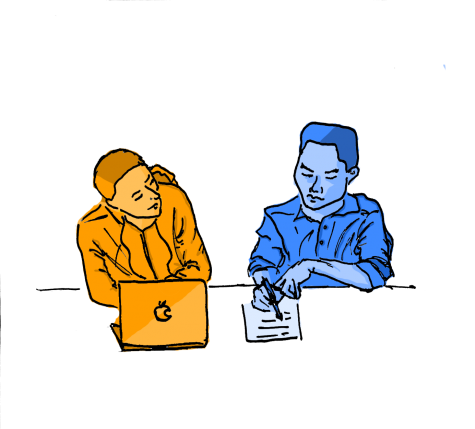Uncovering professional tutoring’s popularity in our community
May 27, 2020

According to a recent Bark survey, 33 percent of Redwood students have only used paid professional tutoring services rather than peer tutoring, which is a free service provided by the school. But why is this?
A US Department of Education’s survey of U.S. high schools in 2017 claims that, “Academic tutoring may be an effective way to help students improve their academic skills, stay in school, and/or graduate from high school.” Redwood High School had a 98 percent graduation rate in 2019; do all these students really need the extra support or are parents and students too quick to jump to professional help?
Another study by TutorsNearMe, a site dedicated to finding tutors for students, analyzed over 34,000 private tutors in California and found that the state’s average price for a single session is $44.77 per hour. But in Marin County, organizations such as Compass Education Group charge $220 an hour, LifeWorks charges $150-250 per hour depending on the tutor and Swell Education Group charges $150-200 per hour. Does this price accurately reflect the quality of help students are receiving or is this an inflated number because of the demand of high achieving students in Marin County?
All of this may not come as a surprise to students, who generally see the prevalence and effect of professional tutoring first hand. Junior Natalie Pemberton started to get tutored her sophomore year during an especially difficult math class: Honors Precalculus.
“I was struggling with concepts in math that I felt like I wasn’t fully comprehending when the teacher was saying them, so I felt like I needed another person to explain them to me,” Natalie said.
Natalie stated tutoring helps open up time for homework and learning outside of class time.
“I now have a bit of structured time in the week to do homework [with a tutor], so I find that I spend a lot less time struggling with concepts and a lot more time quickly understanding. Then the whole week my homework takes less time,” Natalie said.
Now in Advanced Placement (AP) Calculus BC, considered to be the hardest math class offered at Redwood, Natalie appreciates the help from her tutor and believes it helped set her up for success. According to Natalie, the thought of using Redwood peer tutoring has never occurred to her.

Similarly, freshman Lina Ibrahim began tutoring for her math class this year with a paid Redwood senior who is not associated with the peer tutoring program and is not a professional.
“I needed homework help and more help understanding topics, and I wanted to be able to ask more questions [than I could in class],” Ibrahim said.
Ibrahim believes that her tutor has helped her stick to a schedule and get her work done on time.
“A tutor just helps me stay on track with everything. Having scheduled times to meet with them, I can’t put my homework aside to do it another time. I now have set times to do it and understand it,” Ibrahim said. “Tutoring has helped me keep a better schedule and stay more organized.”
Although these reasons are valid, both students said they were unaware of the free programs offered at school and felt that hiring a tutor fit their personal schedule better.
Tutors’ perspective on their students
Tutors in Marin and beyond might have an idea about if the price of their services is worth it or not. Douglas McLemore, a professional tutor of 25 years, began the job full time after being a chemistry professor who did tutoring on the side.
“I didn’t like being in the professor game because I didn’t feel like I was able to get through to students when I had 200-300 students in a classroom. Being a tutor, I’m more able to affect change in my students,” McLemore said.

McLemore thinks his years of teaching experience have led to better tutoring and believes his 20 current students have benefitted from his knowledge.
“It’s easier to figure out what each individual’s problem might be and help them solve those problems when you can do it one-on-one,” McLemore said.
McLemore charges up to $300 per hour for specialized graduate tests (for college students looking into graduate school), or $150 per hour for his basic tutoring services, which although expensive, he believes is worth it for the student and family.
“A lot of the time what happens is I don’t have to spend as much time with a student as someone who is charging a lower rate, so in the end it probably comes out to be a lot closer in cost,” McLemore said. “So what I can do with a student in five hours might actually take another tutor 10-15 hours to accomplish and that’s because I’ve seen a lot of students and can identify problem spots faster.”
Working with students both online and in person through his own company, IcosaPrep, and Swell Education Group in Marin, McLemore has been able to see subtle differences in students based on where they live.
“I think there’s just a more competitive nature here in Marin than in other places, probably because of the schools that are in the area,” McLemore said.
He has also noticed differences compared to other counties in what parents are willing to pay tutors to see their students succeed.
“I do think there is a bigger interest in quality tutoring here, versus college students or just out of college students doing tutoring,” McLemore said. “I don’t think that flies as much in Marin. [Parents] want people who are professional tutors.”
But do families really need to be spending hundreds of dollars per week on tutoring? At Redwood, there are many opportunities for free tutoring and help through peer tutors and SMART periods, a chance to ask questions or talk to teachers. Senior Gianna Panzardi is a peer tutor for a period of math teacher Heather Curtaz’s Algebra students and has seen its impact for the past year.

“It’s kind of like being a teacher’s assistant but you’re not just helping the teacher, you’re working with the kids as well. I’m sitting at a desk the whole class period and I usually help the most on block days when they’re reviewing for their test,” Panzardi said.
Panzardi believes that her job is important in the classroom, and wishes to normalize getting help through extra class time or peer tutors.
“I feel like there are a lot of kids who need peer tutoring but don’t speak up and ask for help, especially underclassmen. They need to know it’s ok to ask for help,” Panzardi said.
Panzardi has always relied on school time to get help, either from friends tutoring her or SMART periods with teachers, and is a firm believer in taking advantage of the resources offered for free.
“There are definitely really great programs offered at Redwood, and there are so many free options, so I don’t feel like people need to hire professional tutors unless a kid is really struggling and they’ve tried all of the free resources,” Panzardi said.
School resources offered at Redwood
The Redwood Peer Tutoring program was founded over 30 years ago, according to Skip Lovelady, a science teacher and the current Peer Tutor teacher. Before Lovelady took over the Peer Tutoring program nine years ago, it was run by the counselors.
“A student would come in and get a slip and request a tutor. The counselor in charge would then match it up with someone who had signed up to be a tutor in that subject,” Lovelady said. “A message would then go out to both students to meet in the library on Monday at 3:30. There were many issues with that because you can only imagine that not both of the students would show up in a given day.”
When Lovelady took over the program, he made it a drop-in service instead, and believes the system is much simpler and easier now.

“We have people who sign up to be peer tutors and they show up to the library and are there, and anyone who needs help just has to walk in and find me,” Lovelady said.
Despite these changes, Lovelady says there are fewer students in the program now, compared to nine years ago.
“Interestingly enough as the school’s population of students has gone from 1,400 to 2,000 in the past nine years, both the number of students making themselves available to be tutors and the number of students asking for help has actually gone down, not up,” Lovelady said.
Charlie Moore, a senior at Redwood, was a peer tutor for his first semester sophomore year, but never got the opportunity to tutor another student.
“It was once a week for an hour after school for the whole semester, but I didn’t see anyone come in to get help with someone they didn’t already know,” Moore said. “There were always six to 10 peer tutors and about half were tutoring [on any given day].”
Lovelady believes the low attendance is due to students being more involved in other extracurriculars and just not having the time to devote to peer tutoring.
“There are fewer students who have free time to come and get academic help and there are fewer students who have free time to help other kids,” Lovelady said.
Lovelady still believes in the benefits peer tutoring can bring for both students involved.
“[Peer tutoring] is really different [from professional tutoring]. When you get a kid talking to a kid, they break it down,” Lovelady said. “A lot of the time, and this is something professional tutors cannot do, the peer tutor will ask who they have for the class and can say, ‘Oh I had her’ and it really quickly escalates into a much different conversation.”
Panzardi also thinks it is helpful to have someone who won’t judge you and who is available to turn to for help in difficult classes.
“I definitely get intimidated to ask questions, so for me, its nice to have a friend [tutor me] whom I’m completely comfortable around because I feel like there’s no judgement and I’m not afraid to ask questions which I think might be stupid,” Panzardi said.
Lovelady also attests that students can be more valuable teachers to their peers compared to a professional tutor.
“As good as many teachers are, we don’t do a lot of one-on-one with our students. What I see in peer tutors is this simple yet complex relationship where they know exactly what the kid needs,” Lovelady said.
Although students can benefit from the program, Moore believes that it needs to be adjusted or changed for that to happen.
“There’s something going on there that people didn’t feel that they could ask for help, or at least they didn’t know how,” Moore said.
No instructors or peer tutors were able to provide student sources that use(d) peer tutoring for this article. For the students who have been able to receive peer tutoring, Lovelady has seen improvement and change and believes it’s an unparalleled opportunity.
“The kid on the receiving end also seems much more relaxed and willing to get help from the junior or senior rather than talking to an adult,” Lovelady said. “I’m the first one to admit, in many cases, more than most people would think, peer tutoring is better [than professional tutoring].”
Peer tutoring is also beneficial for families because it is free. All the student has to do is show up to the library Monday, Tuesday or Wednesday from 3:30-4:30pm.

While peer tutoring is a free resource, it’s not the only one. Peer tutoring is an example of academic tutoring, for a specific class or subject, while The College and Career Center (CCC) offers ACT/SAT help and advice. Opportunities for this include SMART period workshops and one-on-one appointments to go over ACT or SAT planning and college applications. While Becky Bjursten, the College and Career Center specialist, does not actually tutor students for the ACT or SAT, she helps facilitate it.
“I love helping students with problems big and small, whether it’s how to fill out a certain part of an application or problem solving simple questions or problem solving the bigger questions. It’s just fun to support the students and get answers for them,” Bjursten said.
In terms of ACT and SAT help, Bjursten helps organize mock tests every September and January, as well as subject tests every March for sophomores and juniors.
“Compass [Education Group] testing comes and donates those tests to us and I’m there to help make sure kids have access to a full length practice test. They have all the benefits of a private testing company without the cost at least a couple times a year,” Bjursten said.
Not only that, but Bjursten is always open to helping students in and out of school hours.
“I have a lot of test materials in my room, so lots of booklets and the official ones that are put out by ACT and SAT…I also get a lot of people’s sample tests they didn’t use,” Bjusten said.
Additionally, Bjursten is open to supporting students by helping them find other resources, such as paid professional tutors. While she recognizes that it is not right for everyone, she likes to give people options.
“I also keep a list of tutors on the CCC website so people can look at those options and talk to me about those options; They range from free online resources to $300 per tutoring sessions, so I like to make sure students have all of that information before they make a choice that’s right for them,” Bjursten said.
Through Redwood, students have access to numerous free resources such as the College and Career Center for test help, counselors for planning, peer tutors for subject help, and SMART periods for meetings with teachers.
How parents view tutoring
Students who utilize resources such as professional tutoring need financial backing for this, and most often this comes from their parents. Kendra Pemberton, a parent, has utilized professional tutoring in the past for both her son Caden, a freshman, and daughter Natalie.
“Because we’ve moved several times, [our kids] have been in situations where they join a new class. For Natalie, it’s always been Honors or AP where she comes in and maybe she’s not at the same exact level,” Kendra said.
Kendra believes that professional tutoring can be incredibly helpful because it is easy to miss just a few concepts and not understand the rest of the lesson because of it.

“The only subject my family has used tutors in is math and ironically my family is great at math,” Kendra said. “But I think it’s a necessary thing for Natalie and Caden because sometimes you miss a few concepts and can fall behind.”
Kendra recognizes that tutoring can be incredibly expensive; for her family, the hourly cost has ranged from $80 to $125 per hour.
“When I think about the tutoring you’re paying for, it’s incredibly helpful and in my opinion can be necessary, but it’s very expensive so it’s not always an option for all students,” Kendra said.
Despite the high cost, Kendra is willing to pay because she believes in the impact tutors can have in terms of helping students understand the material.
“It’s always been worth it, no doubt. We’ve never had a tutoring situation where it’s not been worth it in the long run,” Kendra said. “My two children having tutors has solidified my belief that it’s a good investment. It’s worth it.”
Since her kids began studying with tutors, Kendra has seen reduced levels of stress and increased confidence in the material for her children.
“[With tutoring], the level of anxiety in the student goes down, their ability to understand concepts goes up, and overall it really helps the learning process,” Kendra said.
Kendra has always believed in the power of tutors because of her own experience in school.
“I have always believed in tutoring because I had a point in my life when I was in junior high school and I was struggling with math,” Kendra said. “My mom got me a tutor, and it was so helpful to me in helping me think differently and do my homework differently that I never needed a tutor again.”

According to Kendra, tutoring is a privilege but should be made available to everyone regardless of price.
“I think if people are struggling, tutoring is a really good option. I think if I were going to recommend tutoring, I would look at the [family] situation and if that’s feasible for the family,” Kendra said. “If cost were out of the picture, I would recommend it for everyone.”
While Kendra believes that the free tutoring resources that Redwood offers are a good opportunity, they are not a perfect fit for every student, which is why she prefers professional tutoring.
“[Free tutoring programs] are great and easier for students who are social rather than those who are shy. I think it’s as helpful [as professional tutoring] and an awesome opportunity, but I think for some kids there could be a little anxiety about going to a student [for peer tutoring] that they go to school with,” Kendra said.
How tutoring affects teachers
Teachers are able to develop personal relationships with students and get to know them throughout the academic year. They are also able to see students struggle and help them, or suggest outside tutoring.
David Nash, a Redwood physics teacher of 25 years, says he loves seeing growth in his students as they learn and take on challenges together.
“I really enjoy being in the classroom with students of a young adult age who are very capable of high level thinking, especially in science. I enjoy the process of explaining physics and seeing them share enthusiasm and find success,” Nash said.
Having years of experience teaching, Nash has seen subtle changes in his classes regarding their attitudes around tutoring.

“When I started teaching many years ago, there wasn’t much private tutoring. When I was a high school student myself, I don’t know that I heard of any private tutoring—it was really uncommon. It’s nothing that’s specific to Redwood or Marin, I just think it’s a sign of the times,” Nash said.
Nash has been able to see why students have reached out for professional tutoring help and why it has become so much more common for his students.
“I don’t think students are any less capable, intelligent or motivated from when I started teaching to now,” Nash said. “A lot of students in my class take three, four or five really hard classes, and the sum total is a lot, so the need for private tutoring is a consequence of having so much going on.”
Nash recognizes that while school resources such as the Redwood Peer Tutoring program can be helpful, many students prefer professional help.
“In our area in particular, with our socioeconomic status, there’s enough money to pay for tutoring. Not that everyone has the money, but many people do. In a lot of communities that money is just not available,” Nash said.
Because only some have this ability to pay for private tutoring, the achievement divide between students who can and cannot receive tutoring can then become exacerbated, according to Nash.
“I think if you have two students with similar capabilities and motivations but a different financial backing, and one gets tutoring and the other does not, you don’t end up with the same results,” Nash said.
Even though tutoring can yield different results depending on the student, Nash thinks that students should be given resources and tools whenever possible, and in his classroom he strives to make this possible.
“In the past few years, I have tried to facilitate tutoring between students so if I have some honors students and someone asking for help, I’ll try to facilitate the connection,” Nash said. “There are also some names of local teachers and professionals who I know that I will refer [students] to.”
However, Nash recognizes that professional tutoring can go wrong in some cases, and it is not always best for every student.

“Here’s what can go wrong about [professional] tutoring: a student who is maybe lacking some motivation and not getting the work done in class now has a tutor and has even less motivation to get the work done in class, figuring, ‘Oh, I’ll just ask my tutor later’ or misses class because, ‘Oh, I can just ask my tutor later,’” Nash said.
Comparing peer tutoring and professional tutoring, Nash believes there are benefits and drawbacks to both. For peer tutors, he believes they offer first hand knowledge that professional tutors cannot always offer.
“The peer tutor who is currently taking the class—they know exactly what we are doing every week and really each day. They understand the context, they understand the lab, because they just did it themselves,” Nash said.
According to Nash, professional tutoring does have some advantages as well and can be better for students who need a new perspective.
“The student doesn’t have the depth of expertise that maybe a professional has, they don’t know the best ways of explaining, where a good teacher or tutor can explain things multiple ways and come up with a new approach and be flexible,” Nash said.
In terms of which is better, Nash does not have a preference, but feels that peer tutors can have benefits that not everyone recognizes.
“Professional tutoring is more consistent and when you’re paying a professional rather than an amateur you might expect better results–sometimes [that happens, but] not necessarily always,” Nash said.
What’s next for the Peer Tutoring Program?
In terms of peer tutoring versus professional tutoring use at Redwood, it is clear that students and families turn to professionals before students more often than not. Whether that is because of the ability to pay for it, convenient scheduling or perception that professional tutoring is “better,” the Redwood Peer Tutoring program is underutilized as a result.
Moore believes that the program could be restructured to change this outcome.
“I think the way the system works made it hard to ask for help in the first place. The [students] didn’t really know what to do.”
Moore also believes that part of the low attendance was a preference for a professional tutor over a peer tutor.
“I think if someone wants a tutor long term they’ll definitely get a professional,” Moore said. “Even if someone wanted help in a subject for even just a few minutes, I didn’t really see that happening [at Peer Tutoring].”
Looking ahead, Lovelady wants to include more students in the program by continuing to make it accessible to both the tutors and students who need help.
“We make it really easy for the peer tutors, and we try to make it easy for [students] to show up…. We also try to make it really flexible for people coming in,” Lovelady said.